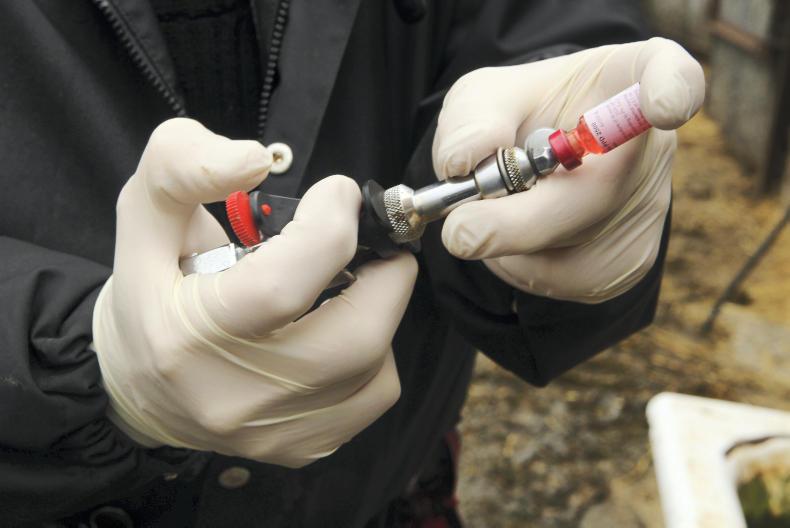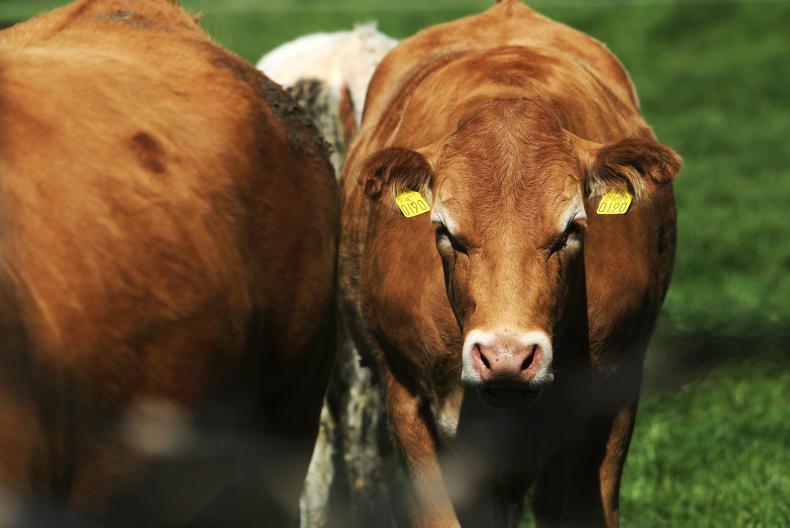“I put cattle into a shed on a B&B basis for feeding for the winter period last year. One day in April this year, I went to check on the cattle and noticed five animals missing from one of the pens. On asking the owner of the shed (contract rearer), I was told that he took them to the mart and sold them. The mart refused to cancel the sale as the cattle were in the contract rearer’s herd number and the contract rearer kept the money. Have you any advice?”
Prior to movement to the contract rearer’s holding, an AIM Certificate of Compliance for farm-to-farm movement must be obtained. There are two ways of doing this – by using either a Form NBAS 31A or Form NBAS 31B. The form NBAS 31A is the form suggested for use in the Teagasc guidelines for the contract rearing of replacement heifers and results in the contract rearer being regarded as the “keeper” of the animals and potentially enables the contract-rearer to sell the animals at a mart if he/she so wishes.
Agreement
Thus it is important to have a written agreement between the parties to protect the animal owners should this occur. This may be contrasted with the form NBAS 31B which stipulates on the form that the ownership of the animals does not change, just the location. As it is stipulated on the form that the ownership of animals does not change, it is not clear whether the contract rearer can sell the animals at a mart without the owner’s knowledge or consent where the movement is notified using Form NBAS 31B. Further clarification has been sought from the Department of Agriculture on the issue and will be published as soon as clarification is received.
The Teagasc guidelines for the contract rearing of replacement heifers provide that when Form NBAS 31A is used, a certificate of compliance is not required for the movement of an animal from the contract rearer’s holding to a mart. Thus, the contract-rearer may present the animal and its passport at the mart and the animal can be presented for sale. This is assuming that the contract-rearer’s herd number is the last recorded location of the animal on the database and provided the animal is in test and all other checks are in order. The guidelines further provide that unless informed to the contrary, the mart will assume that the contract rearer, as keeper on the AIM record from whose herd number the animal is moving is the owner and person entitled to payment.
The guidelines further provide that if the animal owner wishes to move the animals directly from the contract rearing farm to the mart, he is advised to have a written note signed by the rearer stating that the animals have been released back to him by the contract rearer for sale. The mart will then be informed of this note to make payment to the owner of the animals rather than the contract rearer.
Animal identification and movement legislation requires that the passport (blue card) must accompany an animal each time it moves. It is worth highlighting that the AIM system does not record ownership of an animal – it merely records the location of the animal and the current keeper. Therefore, animal identification numbers and ownership details should be clearly stated in a written contract agreement.
While experience has shown that the vast majority of contract rearing arrangements go well, unfortunately there will be cases where things do not go according to plan and that’s when a written agreement becomes important. If you did not enter into a written contract it will be your word against his as to what was agreed between you. Teagasc have prepared two specimen agreements – a flat rate contract and a weight bonus contract. Both are freely available on the Teagasc website. However, the organisation does warn the owner and contract rearer not to sign the document until they understand what it entails and to get the help of professional advisers.
The Teagasc specimen agreement provides as follows:
The owner is obliged to pay to the contract rearer the fees set out in the agreement at the time and manner set out in the agreement.Late payments made by the owner to the contract rearer carry an interest payment of 1.5% per month or part of a month.If a payment is not made within three months, the
contract rearer may sell the animals to recover the unpaid fees having given 14 days’ notice in writing to the owner but refunding to the owner any excess thereafter less costs associated with the sale. Consequently, it is arguable that the contract rearer may have been entitled to sell the animals if payment was overdue for a period of three months. However, this assumes that you had signed up to such an agreement, in the absence of which the oral agreement between the parties will be relied on.
Dispute resolution
Again, how you resolve the dispute may be governed by the terms of the agreement that you signed. If the agreement is based on the specimen agreement prepared by Teagasc, this will provide for a specific dispute resolution mechanism involving a facilitator and conciliator who will make determinations which will not necessarily be legally binding. If the dispute cannot be resolved using the facilitator and conciliator, the matter is referred to arbitration. The arbitration procedure is governed by legislation and any decisions made by the arbitrator shall be final and binding on all parties.
If the agreement you signed up to does not follow the dispute resolution procedure provided for in Teagasc specimen agreement or you did not sign any agreement, it may be open to you to issue legal proceedings against the contract rearer through the district or circuit court depending on the amount owed for breach of contract.
“I put cattle into a shed on a B&B basis for feeding for the winter period last year. One day in April this year, I went to check on the cattle and noticed five animals missing from one of the pens. On asking the owner of the shed (contract rearer), I was told that he took them to the mart and sold them. The mart refused to cancel the sale as the cattle were in the contract rearer’s herd number and the contract rearer kept the money. Have you any advice?”
Prior to movement to the contract rearer’s holding, an AIM Certificate of Compliance for farm-to-farm movement must be obtained. There are two ways of doing this – by using either a Form NBAS 31A or Form NBAS 31B. The form NBAS 31A is the form suggested for use in the Teagasc guidelines for the contract rearing of replacement heifers and results in the contract rearer being regarded as the “keeper” of the animals and potentially enables the contract-rearer to sell the animals at a mart if he/she so wishes.
Agreement
Thus it is important to have a written agreement between the parties to protect the animal owners should this occur. This may be contrasted with the form NBAS 31B which stipulates on the form that the ownership of the animals does not change, just the location. As it is stipulated on the form that the ownership of animals does not change, it is not clear whether the contract rearer can sell the animals at a mart without the owner’s knowledge or consent where the movement is notified using Form NBAS 31B. Further clarification has been sought from the Department of Agriculture on the issue and will be published as soon as clarification is received.
The Teagasc guidelines for the contract rearing of replacement heifers provide that when Form NBAS 31A is used, a certificate of compliance is not required for the movement of an animal from the contract rearer’s holding to a mart. Thus, the contract-rearer may present the animal and its passport at the mart and the animal can be presented for sale. This is assuming that the contract-rearer’s herd number is the last recorded location of the animal on the database and provided the animal is in test and all other checks are in order. The guidelines further provide that unless informed to the contrary, the mart will assume that the contract rearer, as keeper on the AIM record from whose herd number the animal is moving is the owner and person entitled to payment.
The guidelines further provide that if the animal owner wishes to move the animals directly from the contract rearing farm to the mart, he is advised to have a written note signed by the rearer stating that the animals have been released back to him by the contract rearer for sale. The mart will then be informed of this note to make payment to the owner of the animals rather than the contract rearer.
Animal identification and movement legislation requires that the passport (blue card) must accompany an animal each time it moves. It is worth highlighting that the AIM system does not record ownership of an animal – it merely records the location of the animal and the current keeper. Therefore, animal identification numbers and ownership details should be clearly stated in a written contract agreement.
While experience has shown that the vast majority of contract rearing arrangements go well, unfortunately there will be cases where things do not go according to plan and that’s when a written agreement becomes important. If you did not enter into a written contract it will be your word against his as to what was agreed between you. Teagasc have prepared two specimen agreements – a flat rate contract and a weight bonus contract. Both are freely available on the Teagasc website. However, the organisation does warn the owner and contract rearer not to sign the document until they understand what it entails and to get the help of professional advisers.
The Teagasc specimen agreement provides as follows:
The owner is obliged to pay to the contract rearer the fees set out in the agreement at the time and manner set out in the agreement.Late payments made by the owner to the contract rearer carry an interest payment of 1.5% per month or part of a month.If a payment is not made within three months, the
contract rearer may sell the animals to recover the unpaid fees having given 14 days’ notice in writing to the owner but refunding to the owner any excess thereafter less costs associated with the sale. Consequently, it is arguable that the contract rearer may have been entitled to sell the animals if payment was overdue for a period of three months. However, this assumes that you had signed up to such an agreement, in the absence of which the oral agreement between the parties will be relied on.
Dispute resolution
Again, how you resolve the dispute may be governed by the terms of the agreement that you signed. If the agreement is based on the specimen agreement prepared by Teagasc, this will provide for a specific dispute resolution mechanism involving a facilitator and conciliator who will make determinations which will not necessarily be legally binding. If the dispute cannot be resolved using the facilitator and conciliator, the matter is referred to arbitration. The arbitration procedure is governed by legislation and any decisions made by the arbitrator shall be final and binding on all parties.
If the agreement you signed up to does not follow the dispute resolution procedure provided for in Teagasc specimen agreement or you did not sign any agreement, it may be open to you to issue legal proceedings against the contract rearer through the district or circuit court depending on the amount owed for breach of contract.









SHARING OPTIONS